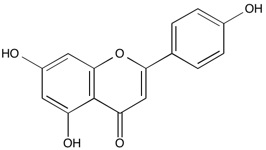Apigenin | Protein kinase inhibitor
NMR (Conforms)

Available Options
| size : | Price | Quantity | |
|---|---|---|---|
| 10 mg | $36.00 | ||
| 50 mg | $130.00 |
Apigenin (520-36-5) is a plant flavonoid with antioxidant properties. It has been reported to have myriad effects on biochemical pathways including kinase inhibition (CK2, PKC, ERK)1-3, CYP2CP inhibition4, inhibition of cellular proliferation via G2/M cell cycle arrest3,5, reduction of HIF-1 and VEGF expression6, and inhibition of nitric oxide and PGE2 synthesis7.
References/Citations:
1) Lin et al. (1997) Suppression of protein kinase C and nuclear oncogene expression as possible molecular mechanisms of cancer chemoprevention by apigenin and curcumin; J. Cell. Biochem. Suppl. 28-29 39
2) Zhao et al. (2011) Apigenin inhibits proliferation and induces apoptosis in human multiple myeloma cells through targeting the trinity of CK2, Cdc37 and Hsp90; Mol. Cancer, 10 10
3) Yin et al. (2001) Apigenin inhibits growth and induces G2/M arrest by modulating cyclinCDK regulators and ERK MAP kinase activation in breast carcinoma cells; Anticancer Research 21 413
4) Si et al. (2009) Mechanism of CYP2C9 inhibition by flavones and flavonols; Drug Metabolism and Disposition, 37 629
5) Sato et al. (1994) Apigenin induces morphological differentiation and G2-M arrest in rat neuronal cells; Biochem. Biophys. Res. Commun. 204 578
6) Fang et al. (2007) Apigenin inhibits tumor angiogenesis through decreasing HIF-1alpha and VEGF expression; Carcinogenesis, 28 858
7) Raso et al. (2001) Inhibition of inducible nitric oxide synthase and cyclooxygenase-2 expression by flavonoids in macrophage J774A.1; Life Sci., 68 921
NMR (Conforms)
Safety Data Sheet:
Product Data Sheet:
Materials provided by Focus Biomolecules are for laboratory research use only and are not intended for human or veterinary applications. Please note that we do not sell to individuals and that all orders placed by non-research organizations will incur a $20 restocking/refund fee
Apigenin (520-36-5) is a plant flavonoid with antioxidant properties. It has been reported to have myriad effects on biochemical pathways including kinase inhibition (CK2, PKC, ERK)1-3, CYP2CP inhibition4, inhibition of cellular proliferation via G2/M cell cycle arrest3,5, reduction of HIF-1 and VEGF expression6, and inhibition of nitric oxide and PGE2 synthesis7.
References/Citations:
1) Lin et al. (1997) Suppression of protein kinase C and nuclear oncogene expression as possible molecular mechanisms of cancer chemoprevention by apigenin and curcumin; J. Cell. Biochem. Suppl. 28-29 39
2) Zhao et al. (2011) Apigenin inhibits proliferation and induces apoptosis in human multiple myeloma cells through targeting the trinity of CK2, Cdc37 and Hsp90; Mol. Cancer, 10 10
3) Yin et al. (2001) Apigenin inhibits growth and induces G2/M arrest by modulating cyclinCDK regulators and ERK MAP kinase activation in breast carcinoma cells; Anticancer Research 21 413
4) Si et al. (2009) Mechanism of CYP2C9 inhibition by flavones and flavonols; Drug Metabolism and Disposition, 37 629
5) Sato et al. (1994) Apigenin induces morphological differentiation and G2-M arrest in rat neuronal cells; Biochem. Biophys. Res. Commun. 204 578
6) Fang et al. (2007) Apigenin inhibits tumor angiogenesis through decreasing HIF-1alpha and VEGF expression; Carcinogenesis, 28 858
7) Raso et al. (2001) Inhibition of inducible nitric oxide synthase and cyclooxygenase-2 expression by flavonoids in macrophage J774A.1; Life Sci., 68 921
Calculate the molar concentration, mass or volume in a solution.
Concentration × Volume × Molecular Weight = Mass
Focus Biomolecules • Plymouth Meeting, PA USA • 1-855-FOCUS21
Focus Biomolecules
Plymouth Meeting, PA USA
1-855-FOCUS21
Website Created by Advanta Advertising LLC.

